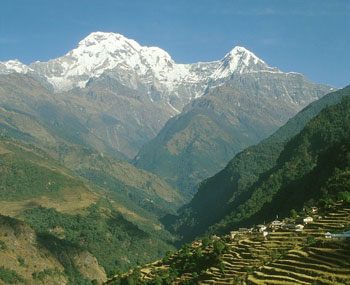Annapurna Conservation Area
 The anapurna region is the most diverse region of any protected are in the World . Recognising the need to protect what is Nepals most highly trekked region,The King Mahendra Trust for Nature Conservation was established in 1986 / Annapurna Conservation Area Project (ACAP) was the first and the largest project of its kind in Nepal covering an area of 7629 sq km. The conservation area embraces a multiple of land-use principles of resource management that combines environmental protection with sustainable community development. Traditional subsistence activities are woven into a framework of sound resource management, supplemented by conservation, development and alternative energy programmes to minimise the negative impacts of what is the most diverse protected region in the World.
The anapurna region is the most diverse region of any protected are in the World . Recognising the need to protect what is Nepals most highly trekked region,The King Mahendra Trust for Nature Conservation was established in 1986 / Annapurna Conservation Area Project (ACAP) was the first and the largest project of its kind in Nepal covering an area of 7629 sq km. The conservation area embraces a multiple of land-use principles of resource management that combines environmental protection with sustainable community development. Traditional subsistence activities are woven into a framework of sound resource management, supplemented by conservation, development and alternative energy programmes to minimise the negative impacts of what is the most diverse protected region in the World.
The biological diversity and sheer beauty of the Annapurna region is equally rivalled by its rich cultural diversity from Hindu farmers to Tibetan Lamas with the natural and cultural features of the region making it the most popular tourist destination in Nepal, drawing more than 60 percent of the country’s total trekkers.
ACAP follows the philosophy of maximum people’s participation, sustainability,its role is one of a catalyst (facilitator) whereby the local people are involved in all aspects of the conservation and development processes, both as principal actors and prime beneficiaries. Educating and involving people to enable them to manage the area with minimum outside influence, e.g each village has its own management committee which is entrusted with the responsibility to manage, utilize and protect all natural resources within its own respective V.D.C. In short to educate and involve people to enable them to manage the area with minimum outside influence.
The project is spread out over 5 districts of the Western Development Region of Nepal and covers 55 Village Development Committees, seven-unit conservation offices are located in the field – Jomsom, Manang, Lo-Manthang in the northern section and Bhujung, Lwang, Sikles and Ghandruk in the southern program section. The focus on the main trekking trails which includes Jomsom, Manang and Ghandruk is one of integrated tourism management and agro-pastoralism. The priorities for Bhujung, Sikles and Lwang (villages in the same district but off the trekking route) are mainly based on poverty alleviation, integrated agriculture and livestock development respectively.
The focus in Lo-Manthang in the remote region of Upper Mustang has been managing controlled tourism on a sustainable basis and promoting heritage conservation. It also works on alternative energy, resource conservation and community development programmes. The Conservation Education and Extension Project (CEEP) is being implemented in the entire area to form the backbone of all conservation efforts in the region.
Find Your Travel Mate
to cut down the cost
Come in a group and get special discounted price.
You will be regularly updated if anyone join into the program that you are intrested in.
Click here
to Write us

